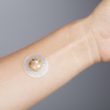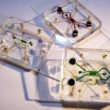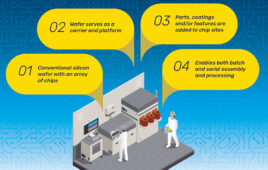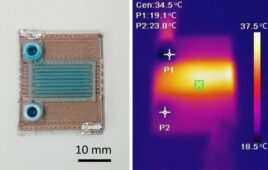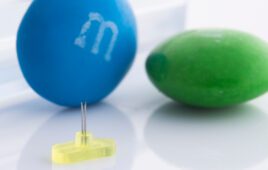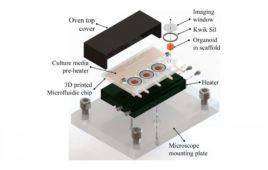
A new system developed by MIT engineers could make it possible to control the way water moves over a surface, using only light. [Image from Jose-Luis Olivares/MIT]
The system was originally designed to help find a way to separate water and oil to treat the mixture of briny water and crude oil in oil wells. When droplets are small and thoroughly mixed with water, it can be hard for usual electrostatic methods to be effective. Instead, the researchers used surfaces that were photoresponsive, which meant the water could be modified when exposed to light.
Surfaces that interact with water were activated by light and could separate the oil from water by causing individual water droplets to fuse and spread, separating from the oil.
The MIT researchers used a layer-by-layer deposition technique to build a polymer-bound titania particle film on a layer of glass. They dip-coated that material with an organic dye. The resulting surface was highly responsive to visible light and the wettability, the ability of water to maintain contact with a solid surface, was much greater when exposed to sunlight than titania. Sunlight helped separate the water and oil mixture.
“We were inspired by the work in photovoltaics, where dye sensitization was used to improve the efficiency of absorption of solar radiation,” said Kripa Varanasi, MIT associate professor of mechanical engineering and one of the researchers, in a press release. “The coupling of the dye to titania particles allows for the generation of charge carriers upon light illumination. This creates an electric potential difference to be established between the surface and the liquid upon illumination, and leads to a change in the wetting properties.”
“Saline water spreads out on our surface under illumination, but oil doesn’t,” said former postdoc and one of the researchers Gibum Kwon. “We found that virtually all the seawater will spread out on the surface and get separated from crude oil, under visible light.”
Water droplets could also be driven across a surface using the same effect, according to the researchers. Changing the material’s wettability with a light beam directs water toward more wettable areas and propels it in any direction with precision.
This method could be used to make microfluidic devices with no built-in boundaries and structures. A blood sample in a diagnostic lab-on-a-chip could be entirely controlled by light being projected onto it.
“By systematically studying the relationship between the energy levels of the dye and the wettability of the contacting liquid, we have come up with a framework for the design of these light-guided liquid manipulation systems,” said Varanasi. “By choosing the right kind of dye, we can create a significant change in droplet dynamics. It’s light-induced motion – a touchless motion of droplets.”
Microfluidic devices are devices that have one or more channels with at least one of its dimensions being less than 1 mm. They are commonly used for whole blood samples, bacterial cell suspensions, protein or antibody solutions and various buffers, according to the University of Washington. Microfluidic devices are used to conduct biomedical research as well.
The materials used for the MIT-developed method are widely available, inexpensive, commodity materials, according to the researchers. The photoresponsive effect is from dye coating and can be tuned by selecting from thousands of organic dyes that are already available. North Carolina researchers have also worked to create inexpensive microfluidic devices using paper.
King Fahd University of Petroleum and Minerals supported this research through the Center for Clean Water and Clean Energy at MIT and KFUPM. It was published online in the journal Nature Communications.
[Want to stay more on top of MDO content? Subscribe to our weekly e-newsletter.]


